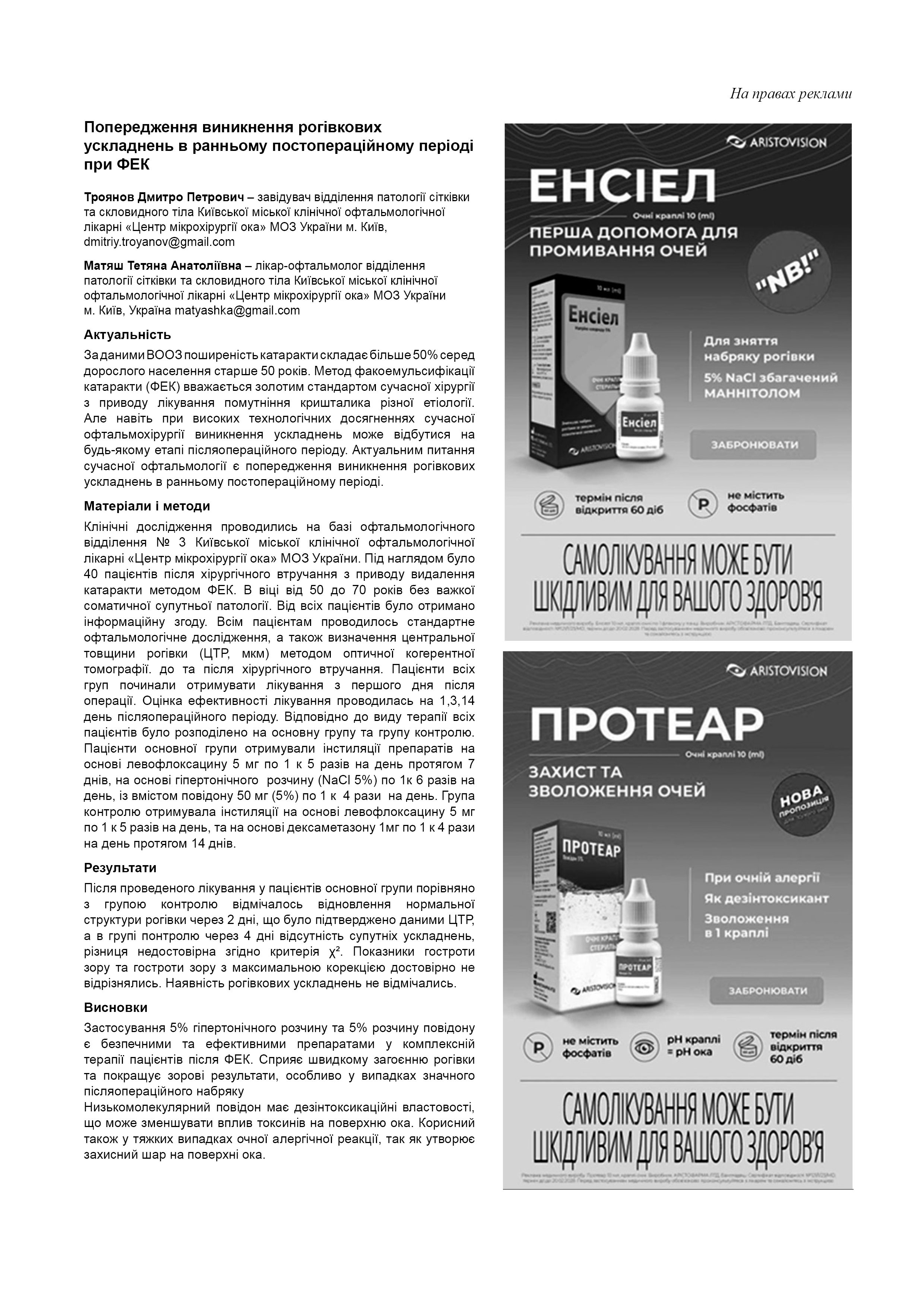Craniofacial malignant tumors, their extensions, and surgical strategy for their treatment
DOI:
https://doi.org/10.31288/oftalmolzh202334955Keywords:
malignant, craniofacial tumors, subcranial approach, orbitozygomatic approach, infratemporal approachAbstract
Purpose: To identify extension routes of craniofacial malignancies and formulate a surgical treatment plan based thereupon.
Material and Methods: We retrospectively reviewed the medical records of 253 patients with craniofacial malignancies who underwent surgical treatment at the Romodanov Neurosurgery Institute from 2002 through 2022. Of the 253 patients, 112 had a primary tumor, and 141, a secondary tumor. Preoperative Karnofsky performance scores ranged from 50 to 70 points. Patients underwent neurological and ophthalmological status assessment, as per routine protocols.
Results: Epithelial malignancies were the most common (53.7%), whereas anaplastic meningioma and embryonal malignancies were rather uncommon (1.2% and 0.4%, respectively) craniofacial malignancies. The presence of certain clinical symptoms was associated primarily with tumor origin and extension. A high rate of general brain and rhinological symptoms in our study sample was caused by a high percentage of intracranial and paranasal sinus tumors. Craniofacial malignancies most commonly originate from the midline (particularly, anterior midline skull base). Ethmoidal labyrinth was the most common site of origin (45.0%), followed by a sphenoid sinus (12.2%), pterygopalatine and infratemporal fossae (9.9%), whereas the cavernous sinus and olfactory fossa were the least common sites of origin (0.4% and 1.2%, respectively). Craniofacial tumors extended most commonly intracranially (transdurally, epidurally, via adhesion to the dura mater, and/or cavernous sinus growth) or intraorbitally. Anterior craniofacial resection (bifrontal craniotomy with combined with either lateral rhinotomy or supraorbital advancement; or a subcranial approach) was the most common surgical treatment. Postoperative cerebrospinal fluid rhinorrhea and infectious complications (meningitis and meningoencephalitis) were the most frequent complications. The overall postoperative mortality rate was 2.0%.
Conclusion: First, compared to the transcranial and facial approaches, the craniofacial resection is advantageous in terms of the radicality of tumor excision. Second, the subcranial approach is preferable to the bifrontal approach in the presence of marked extracranial tumor component, whereas the transbasal Derome approach is effective in the presence of marked extracranial and/or intracranial tumor components. Finally, both the orbitozygomatic and infratemporal approaches allow for the radicality of excision of lateral skull base malignancies, but the latter approach is associated with a lower rate of complications.
References
Зайцев АМ. Краниофациальные блок-резекции при злокачественных опухолях основания черепа. Техника, ближайшие и отдаленные результаты [диссертация]. Mосква;2004. 28 c.
Зозуля ЮА, Заболотный ДИ, Паламар ОИ, Лукач ЭВ, Тимен ГЭ, Гук АП, Рогожин ВА. Диагностика и лечение больных с опухолями краниофациальной локализации. Ринологія. 2002;2:14-23.
Таняшин СВ. Хирургические аспекты лечения злокачественных опухолей, поражающих основание черепа [диссертация]. Mосква;2005. 48 c.
Черекаев ВА. Хирургия опухолей основания черепа, распространяющихся в глазницу и околоносовые пазухи [диссертация]. Mосква;1995. 30 c.
Bilsky MH, Bentz B, Vitaz T, Shah J, Kraus D. Craniofacial resection for cranial base malignancies involving the infratemporal fossa. Neurosurgery, 2005 Oct; 57 (4 Suppl): 339-47. https://doi.org/10.1227/01.NEU.0000176648.06547.15
Cantu G, Riccio S, Bimbi G, Squadrelli M, Colombo S, Compan A, et al. Craniofacial resection for malignant tumors involving the anterior skull base. European Archives of Oto-Rhino-Laryngology and Head & Neck. Springer-Verlag, 2006. https://doi.org/10.1007/s00405-006-0032-z
Daele JJ, Vander Poorten V, Rombaux P, Hamoir M. Cancer of the nasal vestibule, nasal cavity and paranasal sinuses. B-ENT, 2005; Suppl 1:87-94.
Ganly I, Patel SG, Singh B, Kraus DH, Dringer PG, Cantu G, et al. Complications of craniofacial resection for malignant tumors of the skull base: report of an International Collaborative Study. Head Neck, 2005 Jun; 27 (6): 445-51. https://doi.org/10.1002/hed.20166
Licitra L, Locati LD, Cavina R, Garassino I, Mattavelli F, Pizzi N, et al. Primary chemotherapy followed by anterior craniofacial resection and radiotherapy for paranasal cancer. Ann Oncol, 2003 Mar; 14(3):367-72. https://doi.org/10.1093/annonc/mdg113
Liu JK, Decker D, Schaefer SD, Moscatello Al, Orlandi RR, Weiss MH, Couldwell WT. Zones of approaches for craniofacial resection: minimizing facial incisions for resection of anterior cranial base and paranasal sinus tumors. Neurosurgery, 2003 Nov; 53 (5): 1126-35.
https://doi.org/10.1227/01.NEU.0000088802.58956.5A
Origitano TC, Petruzzelli GJ, Leonetti JP, Vandevender D. Combined anterior and anterolateral approaches to the cranial base: complication analysis, avoidance, and management. Neurosurgery, 2006 Apr; 58 (4 Suppl 2): ONS-327-36. https://doi.org/10.1227/01.NEU.0000192680.48095.BD
Raso JL, Gusmão S. Transbasal approach to skull base tumors: evaluation and proposal of classification. Surg Neurol.2006;65 Suppl1:S1:33-1:38. https://doi.org/10.1016/j.surneu.2005.11.037
Ross DA, Marentette LJ, Moore CE, Switz KL. Craniofacial resection: decreased complication rate with a modified subcranial approach. Skull Base Surg. 1999;9(2): 95-100. https://doi.org/10.1055/s-2008-1058155
Wigand ME, Iro H, Bozzato A. Transcranial combined neurorhinosurgicalapproach to the paranasal sinuses for anteriorskull base malignancies. Skull Base. 2009;19(2): 151-158. https://doi.org/10.1055/s-0028-1096200
Sakata K, Maeda A, Rikimaru H, Ono T, Koga N, Takeshige N, et al. Advantage of Extended Craniofacial Resection for Advanced Malignant Tumors of the Nasal Cavity and Paranasal Sinuses: Long-Term Outcome and Surgical Management. World Neurosurgery. 2016; 89: 240-254. https://doi.org/10.1016/j.wneu.2016.02.019
Gil Z, Patel SG, Bilsky M. et al. Complications after craniofacial resection for malignant tumors: are complication trends changing. Otolaryngol. Head Neck Surg. 2009; 140(2): 218-223. https://doi.org/10.1016/j.otohns.2008.10.042
Scher RL, Cantrell RW Anterior skull base reconstruction with the pericranial flap after craniofacial resectionEar Nose Throat J. 1992 May;71(5):210-2, 215-7. https://doi.org/10.1177/014556139207100503
Ketcham AS, Wilkins RH, Vanburen JM, Smitha RR Сombined intracranial facial approach to the paranasal sinuses. Am J Surg. 1963Nov;106:698-703 https://doi.org/10.1016/0002-9610(63)90387-8
Smith R R, Klopp C T, Williams J M. Surgical treatment of cancer of the frontal sinus and adjacent areas. Cancer. 1954;7:991-994. https://doi.org/10.1002/1097-0142(195409)7:5<991::AID-CNCR2820070523>3.0.CO;2-P
Derome PJ. The transbasal approach to tumors invading the base of the skull. In: Schmidek HH, Sweet WH, eds. Operative Neurosurgical Techniques: Indications, Methods, and Results. Boston: Grune & Stratton; 1982:357- 379
Komotar RJ, Starke RM, Raper DM, Anand VK, Schwartz TH. Endoscopic endonasal compared with anterior craniofacial and combined cranionasal resection of esthesioneuroblastomas. World Neurosurg. 2013 Jul-Aug;80(1-2):148-59. https://doi.org/10.1016/j.wneu.2012.12.003
Krischek B, Carvalho FG, Godoy BL, Kiehl R, Zadeh G, Gentili F. From craniofacial resection to endonasal endoscopic removal of malignant tumors of the anterior skull base. World Neurosurg. 2014 Dec;82(6 Suppl):S59-65. https://doi.org/10.1016/j.wneu.2014.07.026
Roxbury CR, Ishii M, Richmon JD, Blitz AM, Reh DD, Gallia GL. Endonasal Endoscopic Surgery in the Management of Sinonasal and Anterior Skull Base Malignancies. Head Neck Pathol. 2016 Mar;10(1):13-22. https://doi.org/10.1007/s12105-016-0687-8
Li LF, Pu JK, Chung JC, Lui WM, Leung GK. Repair of Anterior Skull Base Defect by Dual-Layer/Split-Frontal Pericranial Flap. World Neurosurg. 2019 Feb;122:59-62. https://doi.org/10.1016/j.wneu.2018.10.112
Plinkert PK, Zenner HP. Transfazialer Zugang, kraniofaziale Resektion und Midfacial Degloving beider Chirurgie bösartiger Tumoren der vorderen Schädel basis und der angrenzenden Nasennebenhöhlen [Transfacial approach, craniofacial resection and midfacial deglovingin surgery of malignant tumors of the anterior cranial base and adjacent paranasal sinuses]. HNO. 1996;44(4): 192-200.
Yafit D, Duek I, Abu-Ghanem S, Ungar OJ, Wengier A, Moshe-Levyn H, et al. Surgical approaches for infratemporal fossa tumor resection: Fifteen years' experience of a single center. Head Neck. 2019 Nov;41(11):3755-3763. https://doi.org/10.1002/hed.25906
Cantore G, Ciappetta P, Delfini R. Choice of neurosurgical approach in the treatment of cranial base lesions. Neurosurg. Rev. 1994; 17 (20): 109-125. https://doi.org/10.1007/BF00698763
Lello G. Craniofacial access to the anterior and middle cranial fossae and skull base. Craniomaxillofac. Surg. 1997; 25 (6): 285-293. https://doi.org/10.1016/S1010-5182(97)80028-5
Terz JJ, Alksne JF, Lawrence W Jr Craniofacial resection for tumors invading the pterygoid fossa. Am. J. Surg. 1969; 118 (5): 732-740. https://doi.org/10.1016/0002-9610(69)90220-7
Fliss DM, Abergel A, Cavel O, Margalit N, Gil Z. Combined subcranial approaches for excision of complex anterior skull base tumors. Arch Otolaryngol Head Neck Surg. 2007 Sep;133(9):888-96. https://doi.org/10.1001/archotol.133.9.888
Downloads
Published
How to Cite
Issue
Section
License
Copyright (c) 2023 Palamar O.I., Huk A.P., Okonskyi D.I., Davydenko O.S., Davydenko B.O.

This work is licensed under a Creative Commons Attribution 4.0 International License.
This work is licensed under a Creative Commons Attribution 4.0 International (CC BY 4.0) that allows users to read, download, copy, distribute, print, search, or link to the full texts of the articles, or use them for any other lawful purpose, without asking prior permission from the publisher or the author as long as they cite the source.
COPYRIGHT NOTICE
Authors who publish in this journal agree to the following terms:
- Authors hold copyright immediately after publication of their works and retain publishing rights without any restrictions.
- The copyright commencement date complies the publication date of the issue, where the article is included in.
DEPOSIT POLICY
- Authors are permitted and encouraged to post their work online (e.g., in institutional repositories or on their website) during the editorial process, as it can lead to productive exchanges, as well as earlier and greater citation of published work.
- Authors are able to enter into separate, additional contractual arrangements for the non-exclusive distribution of the journal's published version of the work with an acknowledgement of its initial publication in this journal.
- Post-print (post-refereeing manuscript version) and publisher's PDF-version self-archiving is allowed.
- Archiving the pre-print (pre-refereeing manuscript version) not allowed.



.png)










